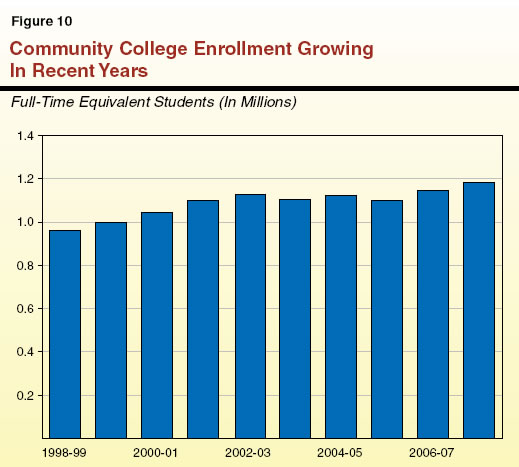2009-10 Budget Analysis Series: Higher Education
What Influences Enrollment at CCC? The state’s Master Plan and current statute require the community colleges to serve as “open enrollment” institutions. As such, community colleges do not deny admission to students. (Instead, students simply register for classes that have available space, usually on a first–come, first–served basis.) Many factors affect the number of students who attend a community college. Changes in the state’s population, particularly among young adults, can be a major factor affecting enrollment levels. Factors such as state educational policies—relating to fees and financial aid, for example—and personal choices of potential students help determine the percentage of the population that enrolls in college (participation rates). Factors such as the availability of specific classes, local economic conditions, and the perceived value of the education to potential students also affect participation rates.
After Period of Decline, Enrollment Up. As Figure 10 shows, after peaking in 2002–03, enrollment levels alternated between modest growth and decline for a few years. Community college enrollment has rebounded in recent years—reaching an all–time high in 2007–08. (This is due in large part to individuals responding to a tight job market.) In fact, enrollment grew so rapidly in 2007–08 that systemwide growth exceeded the budgeted level by 1.3 percent, or about 15,000 FTE students. If funded, this excess enrollment would have required about $65 million in additional apportionment monies. It is important to note, however, that the budget also provided a total of $44 million in “stability” funding—representing almost 10,000 FTE students—for slots that became vacant in declining districts that year.

The 2008–09 Budget Act includes an augmentation of $114 million to fund new enrollment growth of 2 percent, or about 23,000 FTE students. In addition, the base budget retained another $44 million for the enrollment slots that became newly vacant in 2007–08. When these new growth funds are combined with the unused slots from 2007–08, the 2008–09 budget provides CCC with enough funding to accommodate an additional 33,000 FTE students, or 2.8 percent of base enrollment. Based on enrollment in fall 2008, the Chancellor’s Office reports that the system is on track to grow over 4 percent in 2008–09.
Governor Proposes 3 Percent Augmentation for CCC Enrollment Growth. The Governor proposes a total of $185 million to fund 3 percent enrollment growth in 2009–10. This includes $175 million for apportionments, as well as a total of $10 million for three categorical programs that have historically received growth funding. With this augmentation, the Governor’s budget would fund a total of over 1.2 million FTE students in 2009–10.
Recommend Smaller Growth Augmentation. The community colleges are currently facing strong demand for their services as adults seek job retraining and other skills at a time of weak state and national economic growth. For that reason, we recognize a need for additional enrollment funding. As described below, however, we recommend that the Legislature raise CCC fees as part of its budget–balancing solutions. This action would not affect financially needy students (because they are eligible to receive full fee waivers), while the vast majority of nonneedy students would qualify for a full or partial federal tax offset to their fees. It is likely, however, that some fee–paying students who would have attended when fees were $20 per unit would choose not to attend when fees are higher. We therefore believe that such a fee increase would have some small impact on enrollment. Given this, we recommend the Legislature fund a smaller amount of enrollment growth to the extent that fees are raised. A growth rate of 1 percent for apportionments would cost $58 million, for a savings relative to the Governor’s proposal of $117 million.
Return to Higher Education Table of Contents, 2009-10 Budget Analysis SeriesReturn to Full Table of Contents, 2009-10 Budget Analysis Series